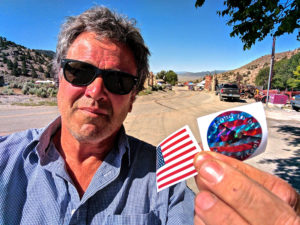 Part out of curiosity and partly as an excuse to get out of the 97 degree sun hammering down on Main St. Ely, NV, I stopped in the shade of a combination thrift shop/art gallery. As I paused idly inspecting the goods in the window a cheery 60-ish Indian lady waved for me to step in.
Part out of curiosity and partly as an excuse to get out of the 97 degree sun hammering down on Main St. Ely, NV, I stopped in the shade of a combination thrift shop/art gallery. As I paused idly inspecting the goods in the window a cheery 60-ish Indian lady waved for me to step in.
“All the work is done by Native artists from the area. Come in, look around. I’m sure you’ll find something you like.”
She went off to rejoin three other women beading at a table by the front window and I turned to give myself a tour. Most of the art work was fairly typical western fare. Sunset landscapes. Wild horses charging across the high desert. Remote watering holes. Derelict windmills. But in a side room an entire wall of 11 x 14 oil paintings of “Heroes of the American West.”
I turned away at first, not all that interested. But then I turned back, struck by one of my recurring curiosities. The “Heroes of the American West”? John Wayne, Clint Eastwood, James Arness, The Lone Ranger, Gene Autry, Festus, Miss Kitty and on and on. “Heroes”. But not even Tonto made the wall of heroes created by the local Native American artist. Even more to the underlying discordance, neither did Cochise, or Sitting Bull, or Chief Joseph or Sacajawea, or hell, Jim Bridger or Lewis & Clark.
Every “hero” on display was, as is so often the case in a culture “educated” with pop mythology, a purely Hollywood creation, which is to say the invention of old school studio heads, many of them first generation eastern European Jews with an uncanny feel for what Americans (and the world) wanted to believe about the Old West and relive, over and over again in endless permutations. In short, in Hollywood’s telling and our understanding, The West was/is a vast land for the taking and holding by strong, generally silent alpha male vigilantes with quick and deadly trigger fingers. By men, and a few admiring women, who applied justice as needed and as they saw it.
Now the Native artist who created the portraits in the gallery in Ely may have had nothing more than the usual starving artist’s commercial interests in mind — i.e. give the people what they want — but the essence of my recurring slap of reality, one that’s amused and dismayed me for years — was reaffirmed.
The preponderance of Western mythology, which is inseparable from our shared American mythology, is largely a pulp fiction. The West of our accepted legend is for the most part a commercial creation by savvy businessmen (and essentially no women). And since it has had no match from a compromised public education system, it has evolved vigorously for a hundred years. As a result we live submerged in a historical psychology where Tom Mix meets Hopalong Cassidy meets John Wayne meets Clint Eastwood meets the Marlboro man meets Ronnie Reagan under a Stetson atop a quarterhorse meets George W. Bush wearing jeans with a big belt buckle clearing brush.
Millions of us grew up with this stuff. (Hell, as first taught to me, George Armstrong Custer was another great American hero. To which in this context you can fairly say, “At least he was real.”) I’d be lying if I didn’t say some part of this fantasy is why given any opportunity I head out West.
As we know well, what we want to believe is at least as powerful as what is authentic and true.
Anyway, as promised, here are some shots of people I crossed paths with while winding around central Nevada earlier this month.
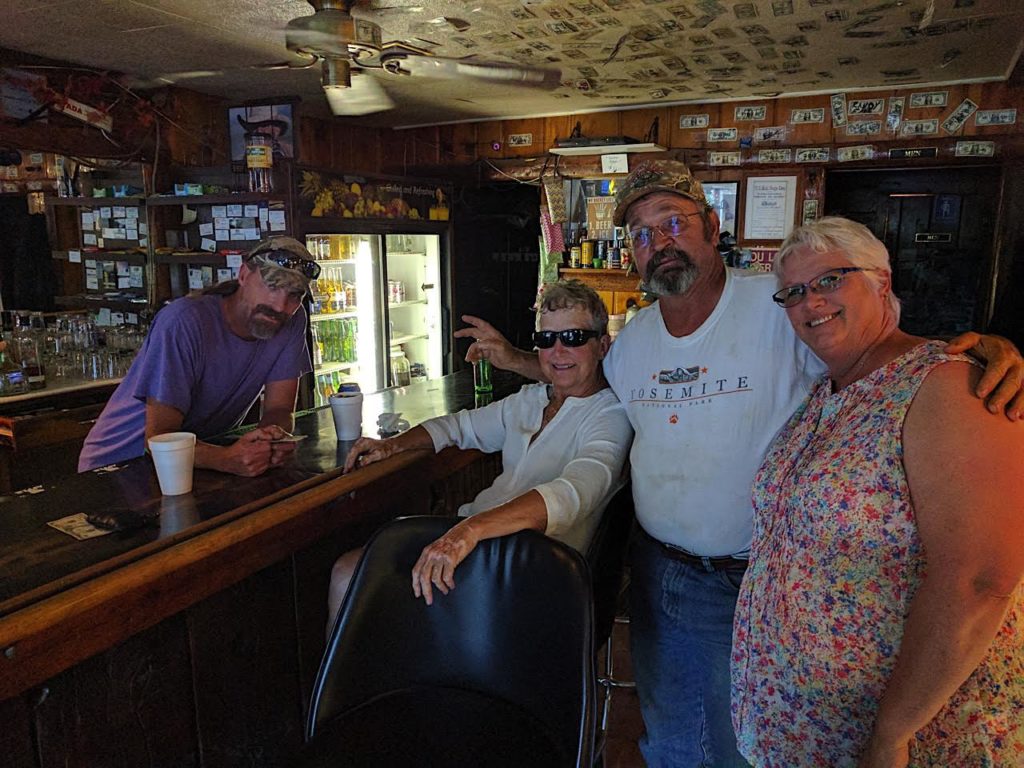
I posted this one from the road. (L-R) It’s Rich the bartender, Linda, Bubba and Janet the Tuscarora, NV. postmaster. What I didn’t mention earlier is that I had been asking various macho dudes in their F-350s and Ram 2500s about getting across the 90 miles of gravel from Tuscarora to Golconda. The general reaction, after surveying my low-riding rental unit, was, “Mmmm. It gets rough. Winter was pretty bad, and they haven’t graded it. You’d be better off going back through Elko and taking [I-80].”
But when I asked Linda, who I’m told has a degree from Northwestern and recently jumped into a corral pen to wrestle a bull calf out of danger, she gave me that sage pause, the slow turn of the head and without dropping her shades to emphasize her point, said, “Oh hell, you’ll make it. Go slow. Watch where you’re going, and don’t do anything stupid.”
I believe that’s something we can all live by on whatever road we take.
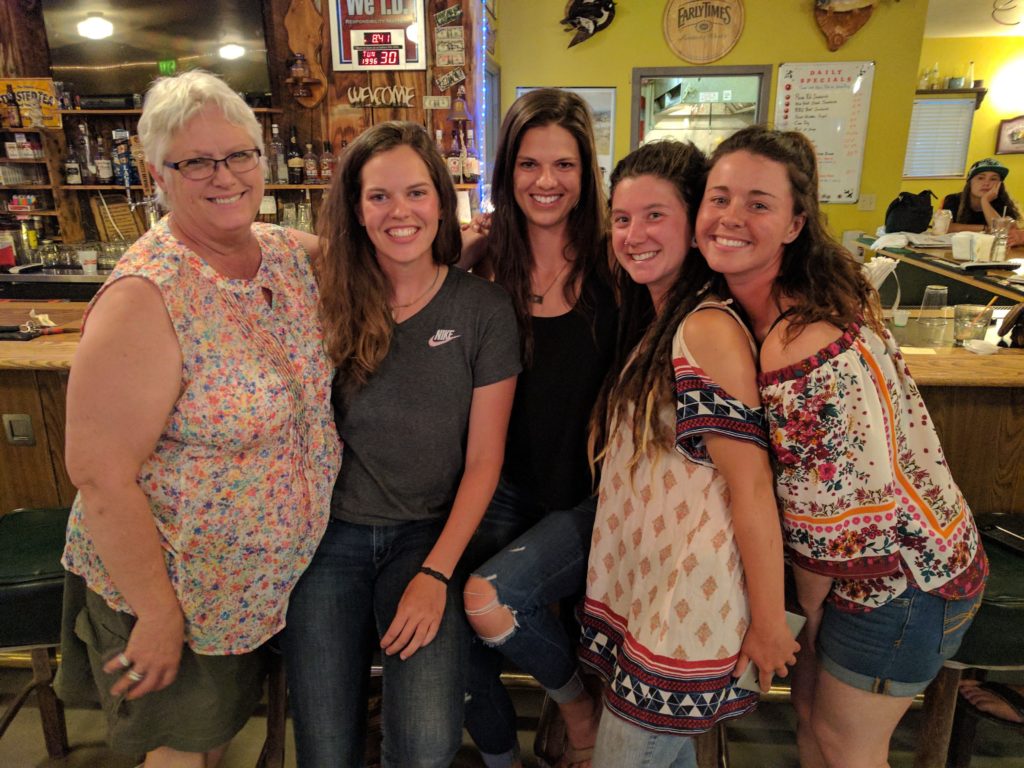
Here is another repeat. My apologies. Janet the Postmaster (left) spent the first half of the summer keeping an eye on and helping out the four college girls in the picture, only one of whom was from “The West” (Bozeman) as they did field work for the U.S. Geological Survey. During the day their job was to walk the vast sage desert and count game birds, a summer gig they picked up via the Texas A&M website. According to Janet, their accommodations were pretty spartan, no showers or indoor plumbing. But from talking to the girls at their going away party it was obvious they had had a hell of a good time. Needless to say, a flock of the local young roosters, a couple of whom had the girls in a kind of flip cup billiards tournament when I left, were taking their own bird count.
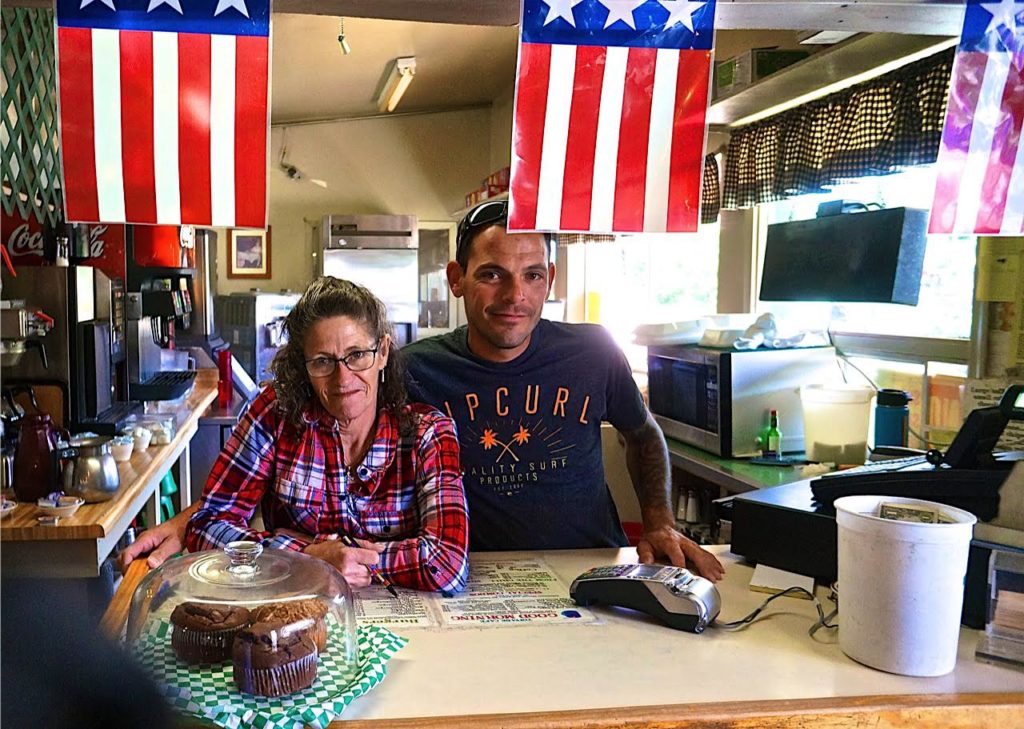
Connie and Bill at the Toyiabe Cafe in Austin, NV. Connie, the waitress is a skinny spark plug, chatting up everyone who walks in. Each of whom is “darlin'” or “sweetheart”. Other than The International, a place down the street covered with Trump and “Make America Great Again” banners, the Toyiabe is the only place to eat in town, unless you count a Snickers bar from the Chevron station. Bill, her busboy is a damaged soul trying to get his life back together — or so I was told (at length) by the gals sitting out front of The Owl Bar the night before. (See below.)
Drug problems led to law problems led to losing contact with his wife and child, who are down in Tonopah while he rents a room from Mary (below) one of Austin’s primary landlords. But she’s told him that his no-accountant twin brother is persona non-grata on her property and should stay that way for Bill’s own good if he wants to get back with his family.
But bad brother was parked out front of the cafe the next day when I drove by after closing time.
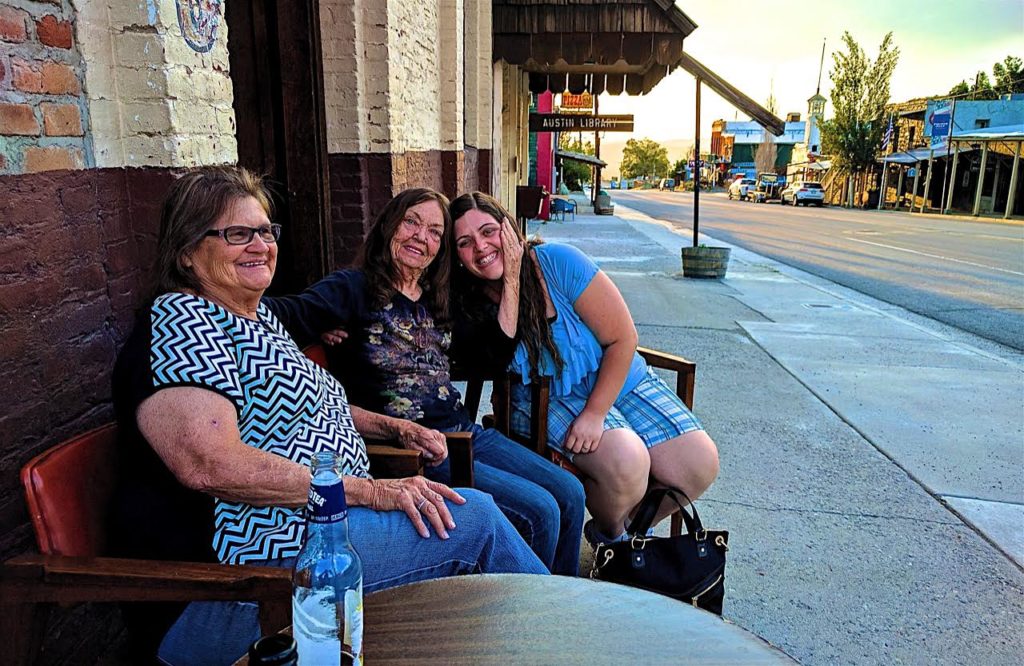
(L-R) Susan, Mary and Mary’s granddaughter Jazzy, up from Vegas for the long holiday weekend. Mary owns several properties in Austin, which looks like a primary destination on a map but is down to a population of barely 200 these days.
Stopping to chat with these gals is an example of the sort of thing you only do if you’re traveling alone. Holiday weekend withstanding there was nothing going on in town, at least not until the bar across the street opened later for karaoke. So, spotting the ladies cooling in the evening shade out front of The Owl, which Mary owns, I asked if they’d mind some company. They didn’t and within a very short time I had a low down on several of Austin’s key characters.
Susan told a story of growing up in another gold mining town “up north” and how as grade schoolers in a company town the kids were let out of class and bused over to the mine every six weeks or so to watch the pouring of a full gold brick.
Truckers making the climb up over the summit, Jazzy’s friends dragging main waiting for karaoke and a couple well-lubricated good old boys in unmuffled pickups either waved in passing or stopped by to exchange jokes and gossip.
At one point Mary mentioned “going to town” for groceries, which made me realize that other than milk and bead and Mountain Dew at the Chevron station I hadn’t seen a grocery store … for a very long time.
“No, we got to go to Battle for supplies, pretty much.” “Battle” being Battle Mountain up on I-80, 90 miles north.
Susan also had a good story of driving over the summit late one afternoon when the sheriff and a wrecker went howling past. When she caught up with them they had stopped and were tending to a guy in a “little red convertible” who had been stunned by a hay bale falling off a big rig and directly into the passenger well of the convertible.
“Thing filled the whole car. I don’t know how he steered it over to the side. Funniest damn thing.”
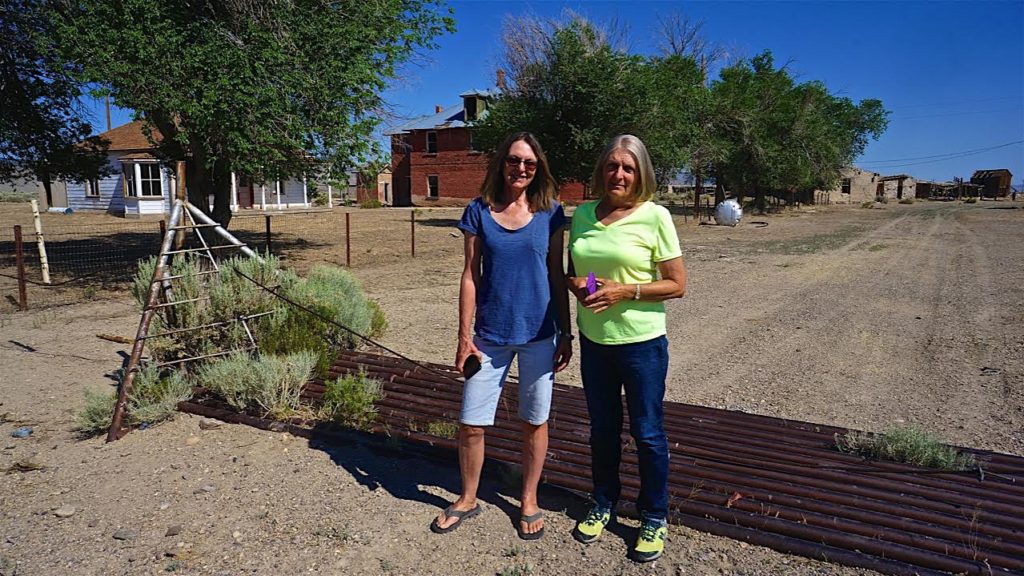
Lisa Lani (right) and her sister (missed her name) in front of what is locally known as “The Hess ranch”, 40 or so miles down the Monitor Valley road. A sucker for ghost towns and deserted ranches, I pulled in to find the sisters, their husbands and another guy talking next to a huge F-350. I quickly learned that Lisa and sister were born in Austria, not far from Hallstadt, but were picked up and moved to this place as grade schoolers, living here until they went away to college.
When I started peppering them with questions one of the husbands groaned, “Oh christ, I told you we’d never get her out of here.”
The short of it is, as Lisa tells it, dad and a small crew worked something on the order of 50,000 aces up and down the valley, which has a minimal source of water. A dozen or more out buildings, including ranch hand bunk houses, are a testament to the size of what was once here.
Fortunes declined. The family sold the ranch and moved into the smaller white, wood frame building in the back ground.
But for a long time, said Lisa wistfully, it was an idyll. The girls rode their horses south down the valley to a one room mud brick school house, now also in ruins, where the teacher both lived and taught. When they were old enough for high school dad drove them the 80-mile round trip up to Austin, morning and afternoon.
“It was wonderful. People tell me they can’t imagine being this far away from everything. But every day was beautiful. The desert isn’t empty like people say. It’s full of life and the colors change every minute of the day. I loved it here.”
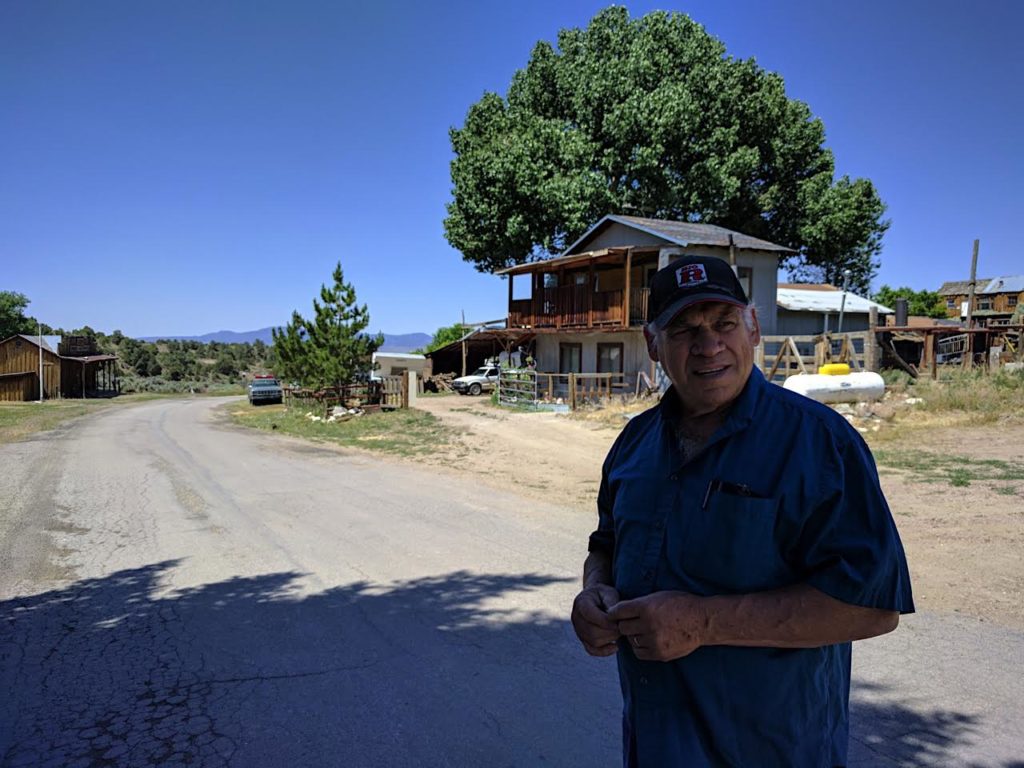
You see signs for Ione, NV. 70 to 100 miles away. So you think you’ll stop by, gas up, have a beverage and see what the locals have on their minds. But when you get to Ione, the guy you meet is John Howe, who with his wife are the sole residents of Ione.
“I’m sort of the caretaker, you might say,” he told me after watching me taking pictures of a the inevitable boarded up saloon and a neatly groomed little park with a historical marker telling about Ione’s (very) short-lived boom era.
“The fella that owns that place,” said John who wears a serious looking hearing aid, pointing to a freshly painted and re-roofed house, “He owns most of what you see. Up there,” pointing to the hillside behind him, “he put in a trailer court for people to rent out. But the state came in and said he had to shut it down, because he didn’t have a license. The trailers are pretty good-sized. A couple are three bedroom. You can have any of them if you pull them out of here.”
Sure enough a half-dozen badly deteriorated mobile homes were parked up on the ridge above Ione.
John has his work cut out just keeping the critters from claiming them completely.
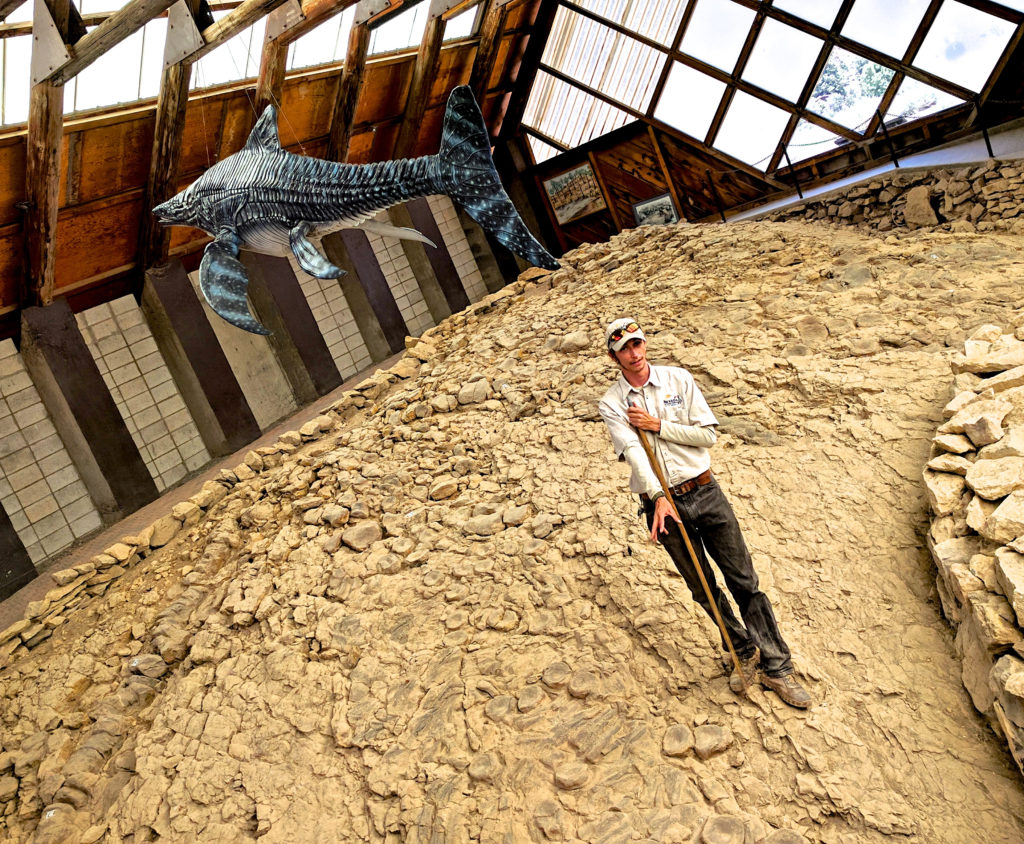
A couple of miles up the mountain from the old ghost mining town of Berlin is Icthyosaur State Park. The story goes that back about 90 years ago a geologist and pal trying their luck at prospecting for gold were poking around when the pal noticed some odd-looking rocks. The geologist, knowing a few things about odd rocks, figured out pretty quickly that they weren’t … rocks. He packed a sample up and sent it off to an archeologist friend. One thing led to another and the young park ranger in the picture above is standing on the final resting spot of at least nine of the largest marine mammals that ever lived, Icthyosaurs, which grew to 70 feet in length, could dive the ancient oceans to a depth of 3000 feet and enjoyed a 160 million year reign as masters of Earth’s primordial seas.
The quarry on which the ranger is standing has been picked over for decades and is now enclosed, sealed away from the elements. My question was: “What’s the theory for how all these giant animals came to die in this precise spot?”
The answer — or best theory — is that on one particular day somewhere in the Icythosaurs’ run from 225 to 65 million years ago, back when this hillside, now at 7000 feet elevation was the coast of an ocean, a poisonous red tide swept in. This particular pod of Ichtyosaurs, possibly swimming in a deep cove, all fed off the same diseased algae, died shortly within hours, sunk to the bottom, were quickly entombed in sediment and spent the next countless millennia turning to stone.
Don’t let that happen to you.
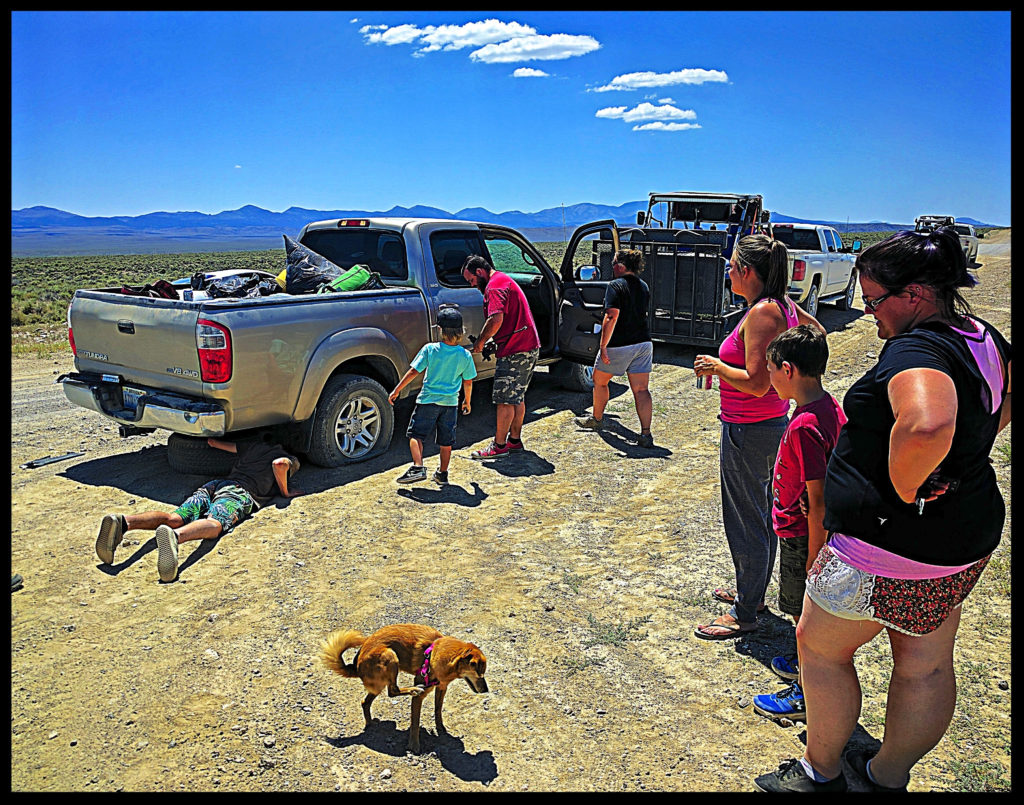
There’s a reason most of the vehicles kicking up huge plumes of dust on Nevada’s back roads have gigantic, $500 apiece 10-ply tires. You don’t want this to happen.
The thought of blowing a tire on a rental car designed for casino parking ramps — is never far from your mind, especially when you come upon this caravan of vacationers (and their staggering amount of motorized recreational vehicles) — pulled over on the side of the road 45 miles from the nearest paved road and easily 90 miles from any “service.”
The ringleader of this repair operation, the guy in the red shirt, was barking orders to the teenage boys to pay attention to how you crank down the full-sized spare, (a truly useful skill set out in the back country, so pay attention kids.)
Any stoppage for any reason is an occasion to pop another beer, and the gal holding one here asked if I was thirsty. (I declined, on the grounds, as the other gal said, “We’ve been out four days and they aren’t that cold anymore.”)
The bigger problem for me was an Austin Powers moment talking to the ramrod shouting instructions. His badly sunburnt face was punctuated by the biggest damn zit I’ve seen on an adult in 20 years. A real high beam beacon positioned smack dab in the center of his beet red forehead.
I couldn’t carry on a conversation because of it.
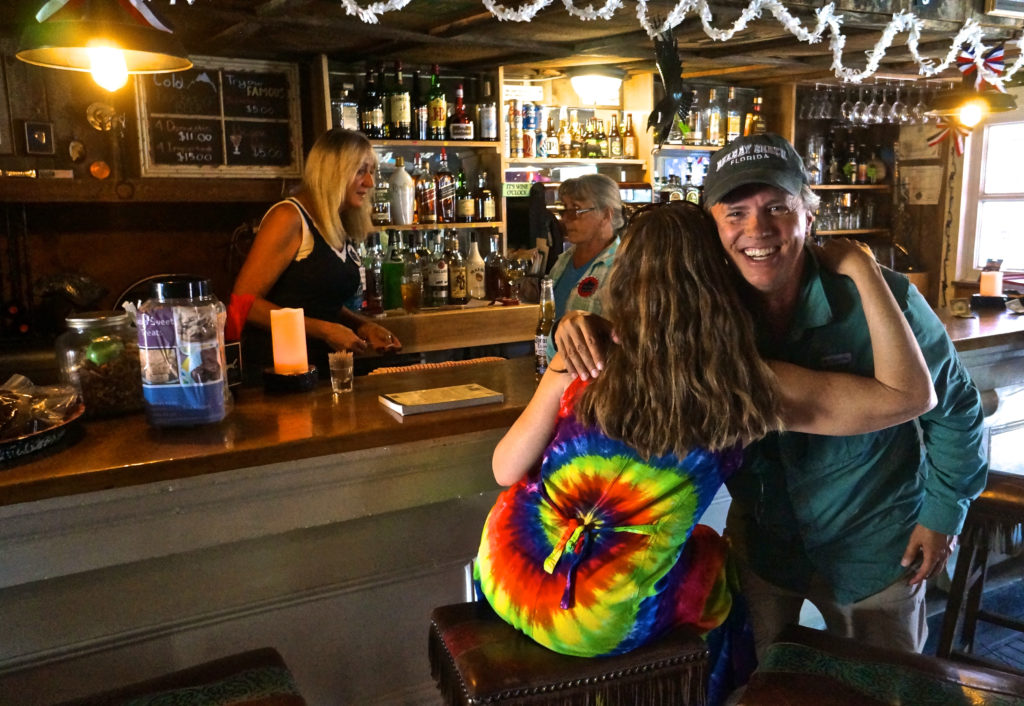
Interesting couple. Larry and Rene, (although her nom de travel is “Desiree”), from Delray Beach, Florida. She’s an on-line professor for Florida Atlantic. He used to be in journalism, but is now selling real estate in the much-recovered Palm Beach County market. Since she has most of the summers off and can check in on-line, they’re on one of their annual two/three-month road trips. They passed by — in their Subaru Forester — while I was pulled over with the caravan fixing the flat tire, and I found them a couple of hours later in Dirty Dick’s Saloon in Belmont, which is as far as I can tell is a ritual pit stop for everyone coming down the Monitor Valley.
The two had a very impressive list of previous destinations on their resume including one still on my bucket list … the Saline Valley deep back in Death Valley. As Larry — who has a kind of Ken Burns affect to his speech and manner — told it, the crew they came upon out there in the way, way back country, was well-outfitted for the environment. Big trucks, big tires, extra gas and extra water, and quite obviously a heavy supply of “some kind of hallucinogens”. “Desiree” soon picked up the vibe that that wasn’t exactly their scene and they moved on.
When she admonished Larry, “no politics!”, (the Trump shit show is not their thing but there’s no point stirring up bad feelings with complete strangers), he shifted the conversation to the moral dilemma of truly full disclosure in the coastal Florida real estate market, where, as Larry tells it, high tide/storm ocean flooding because of rising sea levels is already effecting neighborhoods people are still avidly interested in buying into.
And no, Desiree does not like having her picture taken.
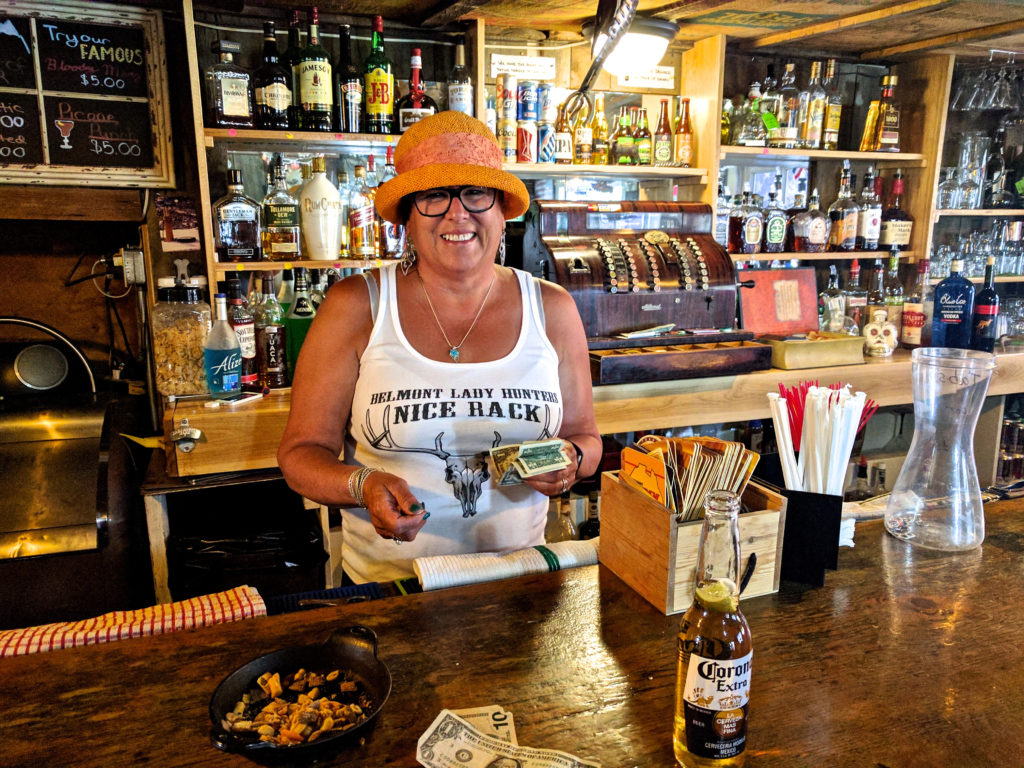
Sue, (if I remember right), one of the bartenders at Dirty Dick’s, proudly wearing one the celebratory hats another gal was handing out. Besides making change for my latest cold Corona she’s telling me that the cash register behind her hasn’t left the bar in over 50 years.
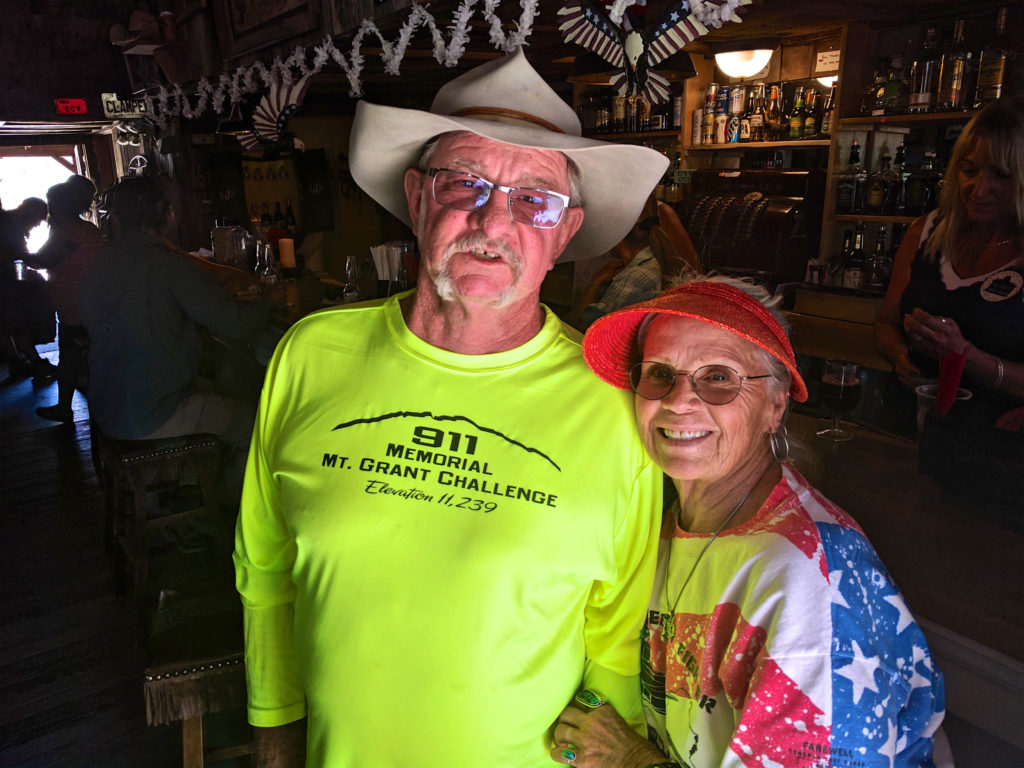
Lori and Bill, (again, as I remember it, since the names came pretty fast and the mix of beverages and sun played with my head.) Lori is what you might call Belmont’s local “doer”, the gal who is in the middle of every organized activity and events. At one point she took me by the elbow and gave me a tour of the photos hanging on the walls and ceiling of Dirty Dick’s. Photos that included deceased husbands branding cattle and doing other bona fide cowboy things. Also included were cow gals in fine, funky outfits lassoing and generally looking good on their horses. One of them included “Birdy”, who at that moment was tending bar and had poured my most recent beverage.
At one point I overheard her going on about “the Kretschmer girls” who sang with the Pea Vine Valley Pickers the night before. They did a helluva job, she said, “they sounded great”. Did I mention her full name is Lori Kretschmer?
Bill (possible sic) is a retired Air Force officer. He is clearly one of the area’s solid citizens. Where he sits others congregate. At one point he came over as I was rocking on the front porch waiting for the big Fourth of July parade to start and said, “I can take only so much of this. By three or so I’ll need some space. If you’re interested I could show you some spots farther up the mountain, over toward Manhattan, places that are really worth getting to.” It was an attractive offer, but, as I told him, my schedule, such as it was, required I get in range of Beatty by nightfall, plus I kind of doubted my dust-caked rental vehicle would survive the abuse of the mountain side roads.
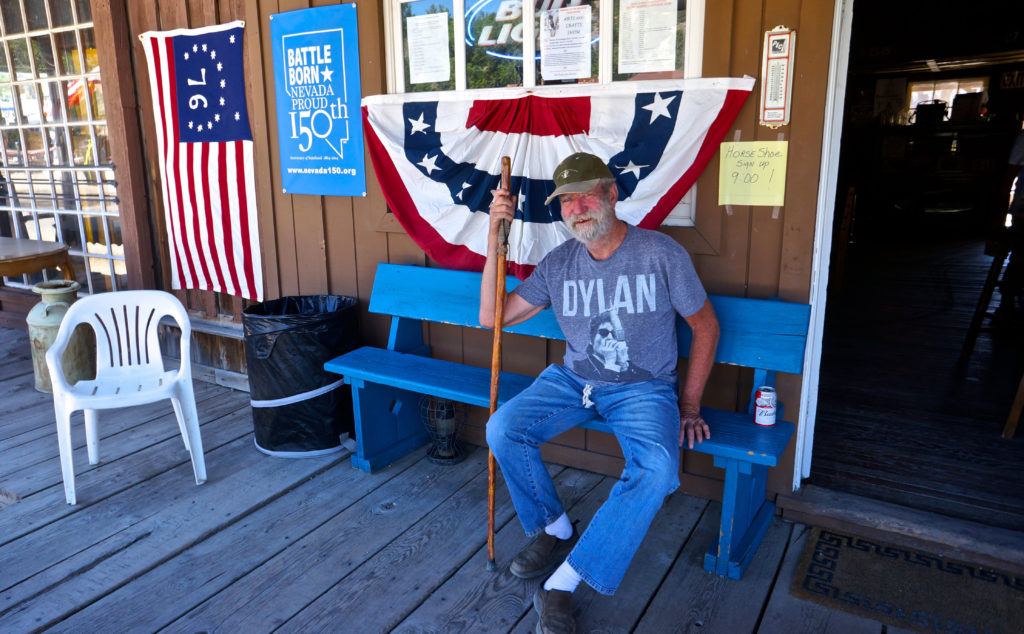
Gordon here, sitting on the front porch of Dirty Dick’s, was, he says, a foreman for a long while at the giant Round Mountain gold mine on the other side of Shoshone Mountain in the Big Smoky Valley. The staff is not an affectation. Nor is the Dylan shirt. “The best ever,” he said. “Never anyone better. Unless it was Leonard Cohen.”
The mining company that has already shaved off and excavated Round Mountain is now following a vein of gold — really just fractions of ounces per ton — which may mean taking down all the company infrastructure near their colossal open pits and moving Nevada State Highway 376. As Gordon explained it, the giant valleys of central Nevada are all alluvial fill, hundreds of feet deep. With all the equipment — and an entire company town — in place, it makes sense to just keep digging.
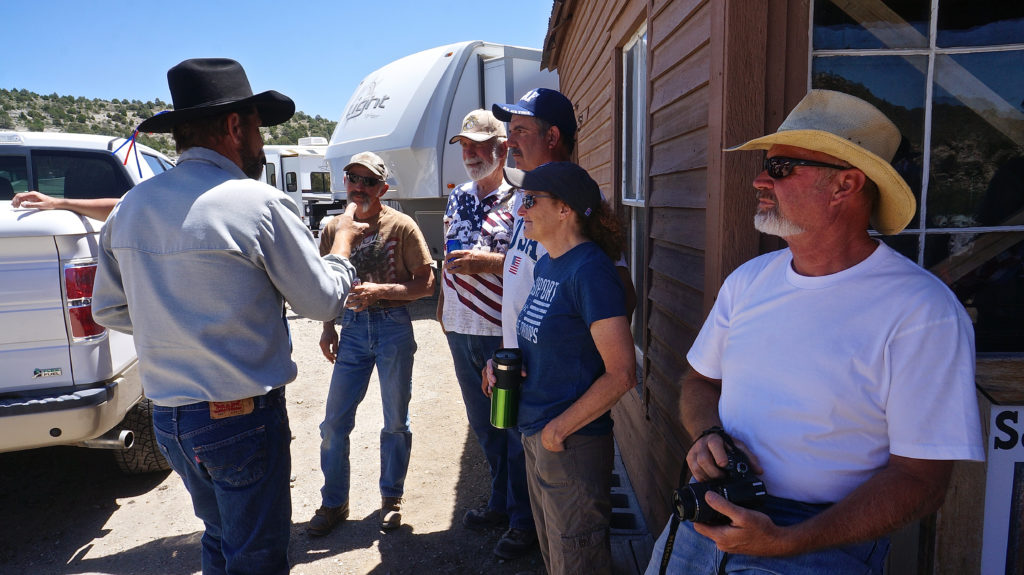
Every society and every community has its alpha male, and by my measure the guy in the black hat is Belmont’s. I never got his name, because every time I bumped into him two or three other people were trying to get his attention. Clearly, being acknowledged by the guy held honor for those who negotiated themselves in his orbit.
What I know for sure is that he played the night before with the aforementioned Pea Vine Valley Pickers, “and a dozen fifteen [other] times over the year.” And when the big Fourth of July parade kicked off, led by two vehicles, one a Nevada State Trooper and the other a local Sheriff, (who I believe were husband and wife), Mr. Alpha here was the guy who trotted out as they moved slowly down the main drag waggling cans of beer at the grinning officers.
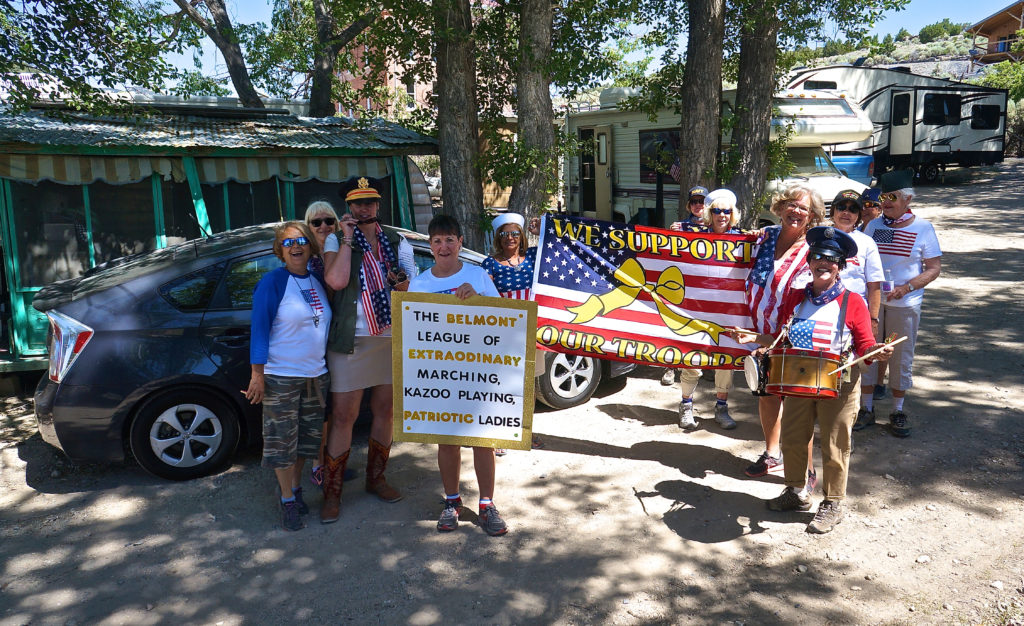
Revving up for the parade, the local gals, just down hill from the old Belmont Court House in the RV encampment, were in good tune if not exactly in full Rockette-style step.
The whole day was rich Americana. But I couldn’t help but notice that the entire definition of patriotism on display — in word and ceremony — was attached to the military. The full range of the idea of independence and freedom, for anyone of any race or religion? Not nearly so much as honoring their men who had and were serving.
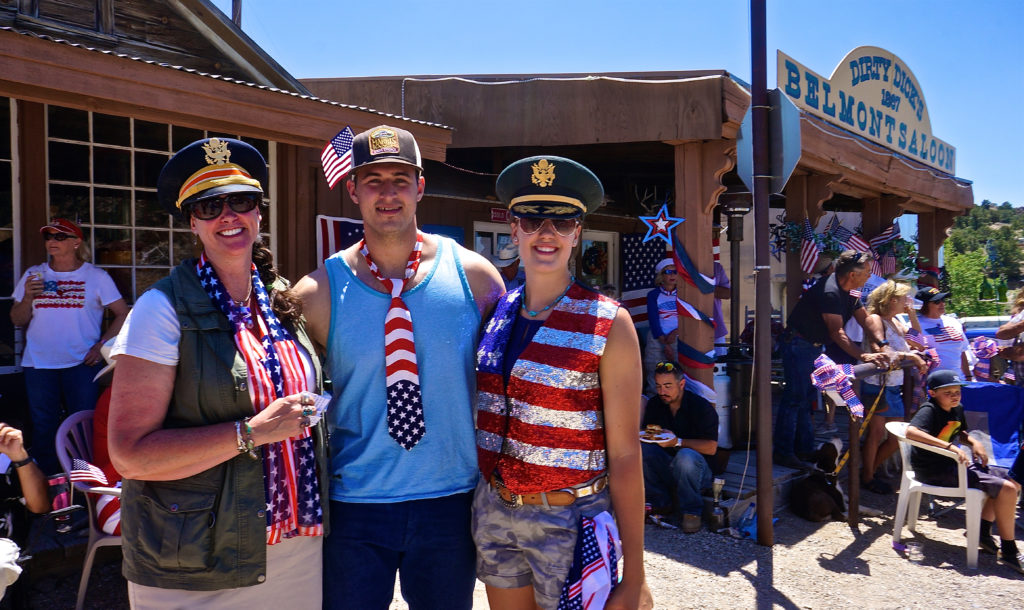
Genetics are destiny. Mom (left) is one of the kazoo-playing patriotic ladies and stands about 6’2″. Bouncing baby boy is three or four inches taller and a densely-muscled 280 to 300 pounds. NFL defensive end-sized, although maybe a little heavy-footed for that position. Little sister though is at least as tall as mom and a stone cold statuesque stunner. Something tells me dad was not Wally Cox.
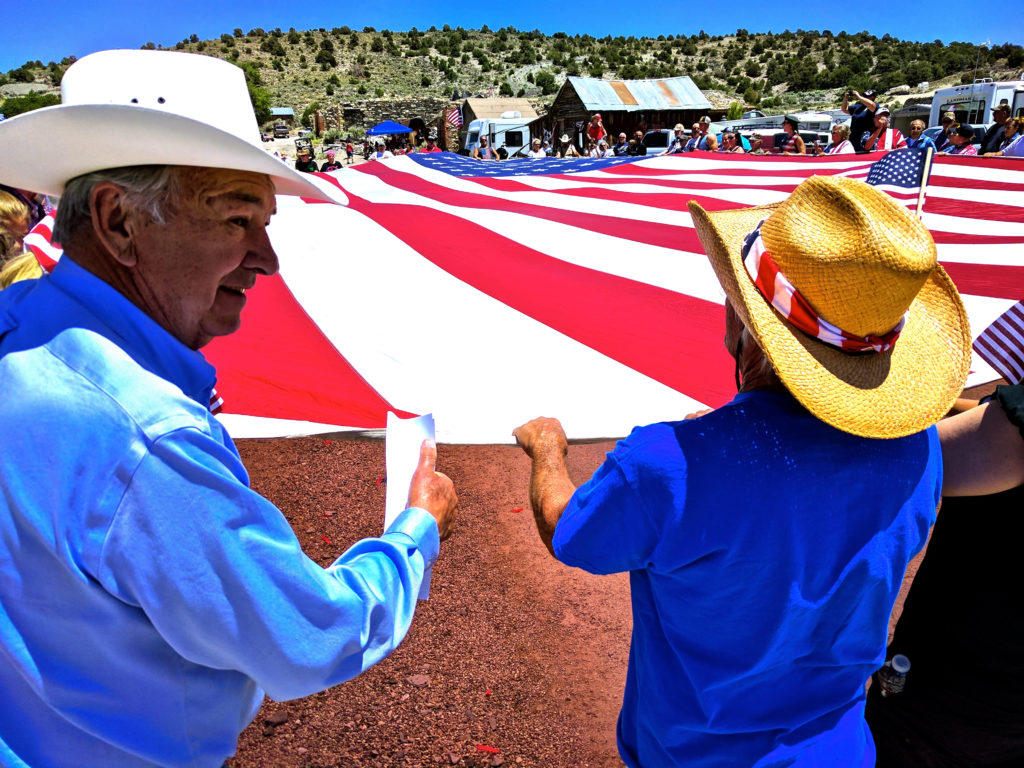
Bob Perchetti, in the white Stetson, “owns a third of Tonopah”, according to one guy on Dirty Dick’s front porch. For sure he owns Tonopah’s semi-legendary Clown Motel, which recently had a run of bad press because of that “The Great American Clown Scare” that went around the country last year, playing off Stephen King’s “It” with malevolent, murderous clowns.
At first I thought he was some local politician for the way he made a point of shaking every hand he found,, including mine. “Nice to meet you, I’m Bob” he said. “Nice to meet you,” I replied. “I’m a tourist”.
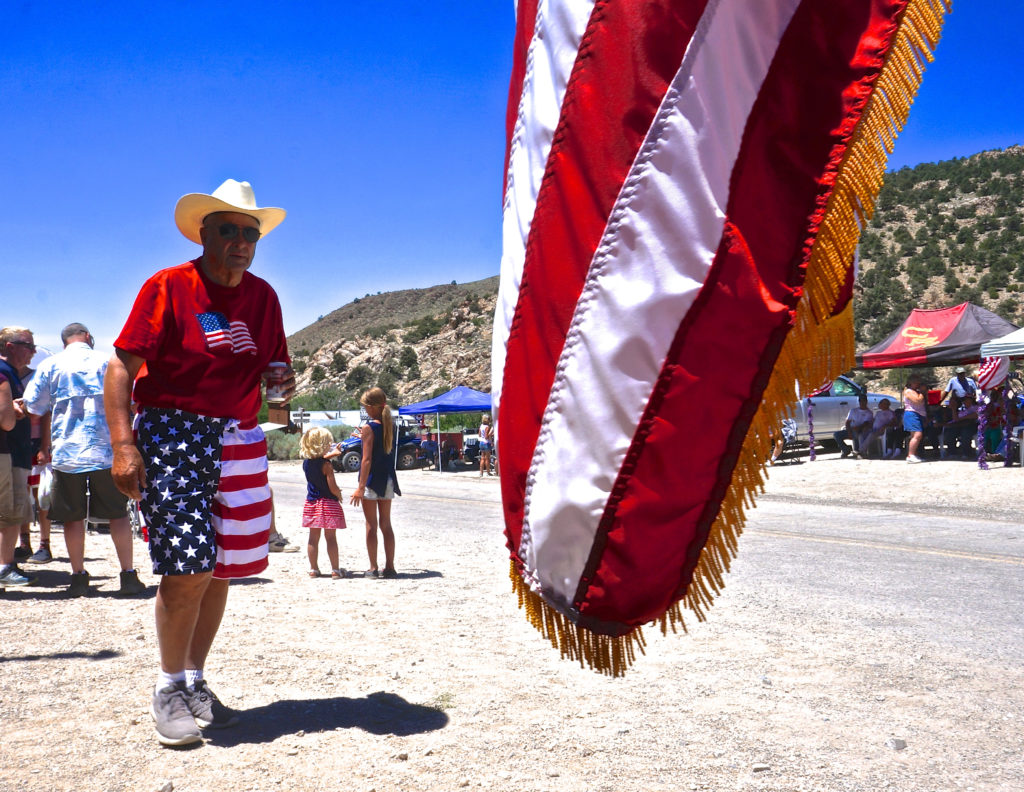
Never got this dude’s name. But he arrived early and stayed late.
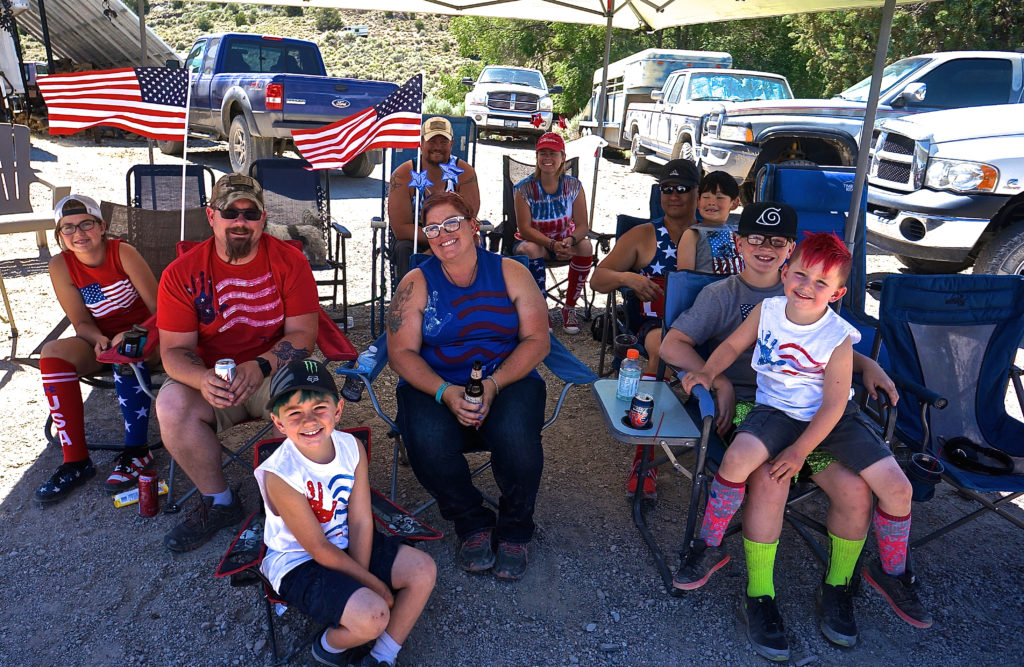
As far as the inner-mountain West goes, this is about as ‘Murican as it gets. Right down the lot full of pickups.
I kept an eye out for the cliche open-carry chowderheads playing Clint Eastwood-meets-name your favorite movie vigilante, but came across only one anywhere, a blubbery guy packing heat while checking out the quilts for sale at Belmont’s Old Court House Art Fair. But then you never know when ISIS is going to parachute into a ghost town and terrorize the quilting ladies.
Fella’s gotta be ready to be The Hero.
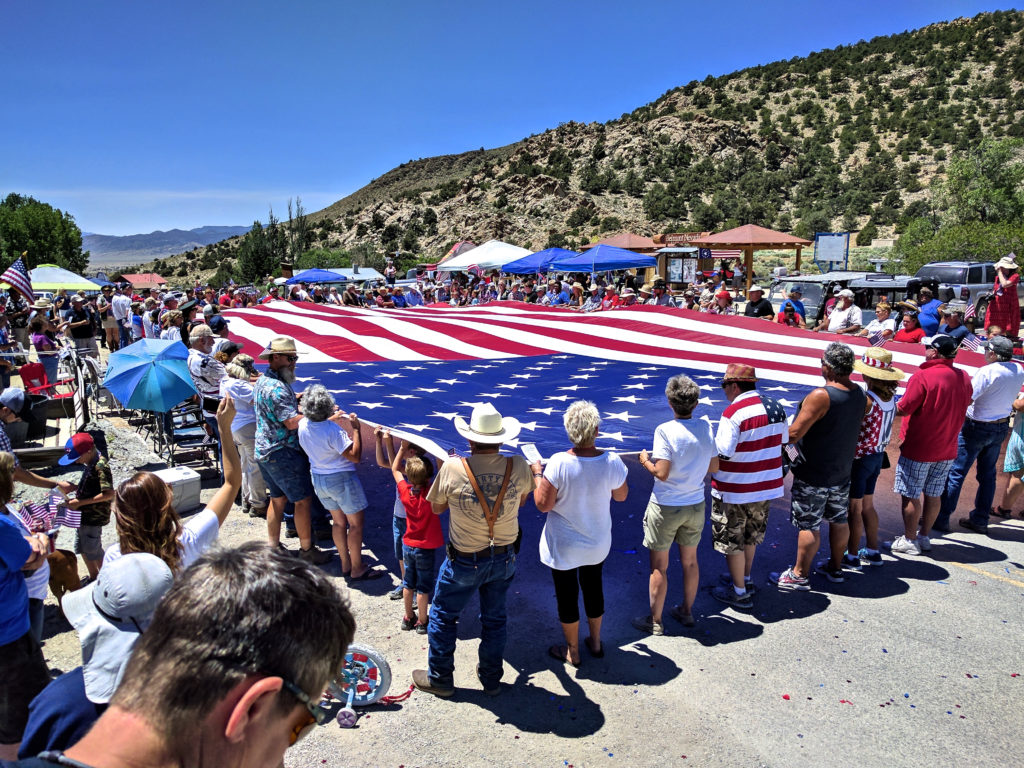
July Fourth, 2017. The flag ceremony. Belmont, Nevada.

Nice long read, Brian. Thanks.
kay
This is brilliant.
Editor’s Note: Wry Wing Politics is reevaluating its decision to pay Lambert by the word.
Hello Brian, Great photos and stories! ~ Jeff